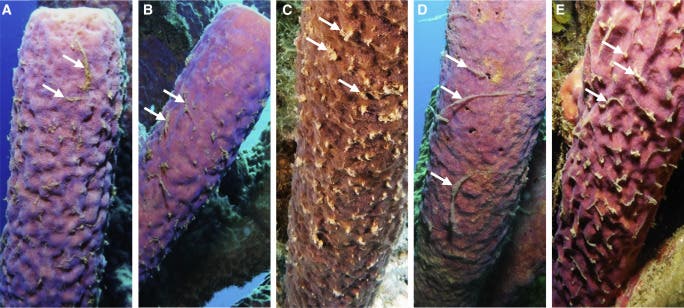Sneezing seems to be as old as life itself, or at least, as old as multicellular life.

Sea sponges are some of the most ancient forms of animal life on the planet. Their age is matched only by their simplicity: these are some of the first multicellular organisms to ever spawn in Earth’s primordial sea. There, they dined on bacteria and single-cell algae which they filtered out of the waters.
This leaves one obvious question: what did they do with the waste? Did they poop? New research shows that no, they do not; but they do sneeze!
Sneazy clean
“Our data suggest that sneezing is an adaptation that sponges evolved to keep themselves clean,” Jasper de Goeij, a marine biologist at the University of Amsterdam and author of a new paper describing the behavior, said in a press release.
“Let’s be clear: Sponges don’t sneeze like humans do. But both sponge and human sneezes exist as a waste disposal mechanism,” he added.
The research is based on a series of time-lapse videos that capture this behavior. The findings, de Goeij’s team explains, could help us better understand how sponges evolved and how these deceptively simple creatures managed to stick around, unchanged, for almost half a billion years, while completely lacking brains or centralized nervous systems.
The study focused on two species, the Caribbean stove-pipe sponge Aplysina archeri, and a species of the genus Chelonaplysilla from the Indo-Pacific. Video recordings show how these sponges ‘sneeze’ by contracting their entire bodies to remove waste.
As stated before, sea sponges are filter feeders. They capture organic particles such as bacteria or plankton from water flowing through pores in the sponge’s body.
However, these pores can become clogged with various materials that the sponges can’t or won’t eat, or the remains of digestion. This blocks the flow of water and can completely impair their ability to feed. If this happens, the sponges need to remove the blockage — and they’ve developed the sneeze-like mechanism as part of this process.
In the videos, the pores that cover the sponges, known as ostium, can be seen slowly excreting waste-containing mucus, which then accumulates on the surface. Occasionally, the animals will contract in a slow sneeze-like motion to remove this buildup.
Although it might sound a bit yucky to us, marine life doesn’t seem to agree. The researchers report that fish and other animals were observed seeking out the released material to feed on it.
“Some organic matter exists in the water surrounding the coral reef, but most of it is not concentrated enough for other animals to eat. Sponges transform this material into eatable mucus,” Kornder, a study co-author, said in a press release.
It seems that most if not all sea sponge species engage in this behavior as a way to clear out their pores.
Researchers say the evidence from their study and other scientists’ deep sea dives suggest most, if not all, sponges sneeze. Still, many things are uncertain regarding the behavior.
“In the videos, you can see that the mucus moves along defined paths on the surface of the sponge before accumulating,” Kornder said, adding, “I have some hypotheses, but more analysis is needed to find out what is happening.”
The paper “Sponges sneeze mucus to shed particulate waste from their seawater inlet pores” has been published in the journal Current Biology.









